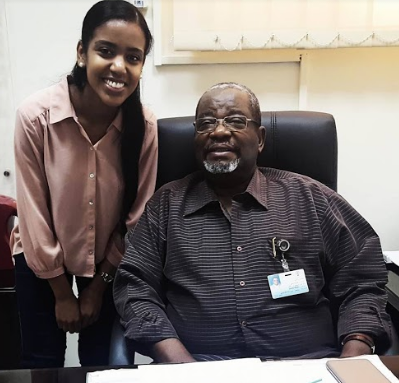Human Practices: Health
Interview with Professor Rotimi: Clinical Microbiologist
Generating a deeper understanding of critical world health issues related to SMITe
Professor Vincent O Rotimi, MD, PhD, FRCPath, is a university professor of clinical microbiology at the Faculty of Medicine, Kuwait University. He is also a longstanding consultant and Head of the Clinical Microbiology Unit at Kuwait’s largest laboratory in Mubarak Kabeer hospital, and an active researcher who has published numerous papers on microbiology, antibiotic resistance, anaerobic bacteriology, hospital infections and various diseases.
The purpose of the interview was to discuss critical topics regarding antibiotic resistance in Kuwait, how these risks have been realized in hospitalized patients treated, for example, in the intensive care unit, and to discuss the microbiology of chronic diabetic wounds.
The interview concluded with a discussion about how our product SMITe could find its place as a potential therapeutic solution to excessive antibiotic prescriptions for chronic wounds and the adaptations is might require.
Following the interview we reflected on the topics covered and formulated a list of questions we now needed to address in order to make our concept acceptable and useful. This is viewable in our Integrated Human Practices page.
Many thanks to Professor Rotimi for his participation. (Pictured with iGEM team member Betty, below).

*Question: I would like to start by asking a few questions regarding antibiotic and multidrug resistance (MDR) in the local area. This is to give us a brief understanding of antibiotics and the increasing risks of MDR caused by the overuse and misuse of antibiotics.
Answer: Good morning Bethel. First of all let me define what an antibiotic is. Antibiotics are naturally occurring or semi-synthetic chemical substances that inhibit the growth of bacteria and are used extensively in medicine for the treatment of bacterial infections. However, they are not a panacea for every bacterial infection. They are beneficial and in many cases life-saving. Despite these desirable effects, they can unfortunately produce dangerous toxic side-effects. The risk of developing resistance is another serious downside of these wonderful chemical compounds. Methods by which bacteria become resistant to antimicrobial agents include, 1) an alteration in permeability of bacterial cell wall to the antibiotic, 2) an alteration in the target binding sites on the bacteria, 3) use of an alternative metabolic pathway, 4) mutation on a gene coding for antibiotic-destroying enzyme and 5) acquiring a new gene for an antibiotic-destroying enzyme. The genes that mediate antibiotic resistance can be transmitted between organisms of the same species (intra-transfer) and species of different genera (inter-transfer). As a result resistance to commonly used antibiotics can become widespread in previously susceptibility organisms. These genes (DNA) are transmitted by 4 mechanisms: transformation, transduction, conjugation and transposons. Some Gram-negative bacteria may acquire multiple resistance determinants gathered together on one of these transmissible elements thereby making the organisms difficult to treat and eradicate from hospital environment. Klebsiella pneumoniae and Acinetobacter baumannii containing these types of elements are good example of multi-drug resistant (MDR) pathogens circulating in many hospitals, including our hospital here in Kuwait.
Question: How could the risk of future (infectious) outbreaks be reduced? Could we prevent this from happening?
Answer: Overuse and misuse of antibiotics help to exert selective pressure for these MDR bacteria. To eradicate the existing MDR organisms from the hospital environment all possible selective pressures must be avoided by judicious prescription and use of antibiotics and excluding the antibiotics to which the bacteria are resistant from susceptibility reports. The Hospital Infection Control (ICC) Unit of any hospital has an important role to play in the prevention of outbreaks. For successful prevention and control the infection control doctor/nurses must be very active and liaise regularly with the microbiology laboratory so as to be able to identify any potential outbreak early before it festers. We have an ICC in the hospital that meets every month or every 2 months and an infection control team (ICT) charged with the tasks of carrying out the day-to-day duties of the ICC. Education of healthcare providers on antibiotic stewardship, resistance surveillance and periodic publication of local antibiogram by the microbiology laboratory are also important.
Question: Are there any other therapeutic options except new or higher potency antibiotics to help in the battle against MDR organisms?
Answer: We have limited options for the treatment of infections caused by MDR bacteria. Unfortunately, the prospects of developing new anti-infective agents is very dim. The pipe-line is dry, as they say. The cost of production of antibiotics is extremely high and very few pharmaceutical companies are willing to take on the task. We are left with previously abandoned drugs like colistin, because of it's toxicity, to treat many MDR infections. Even then, recent reports have emerged describing plasmid-mediated colistin resistance in Escherichia coli. This is not good news as the prospect of colistin resistance spreading among the Enterobacteriaceae will be dangerous. It means you are going to have more pan-resistant organisms causing infections in the future and more and more patients will die as a result. So we need new antibiotics to help the few that we have right now.
Question: Your studies in the microbiology of diabetic foot ulcers were intriguing; the fact that you found the commonest agents isolated were Pseudomonas aeruginosa and Staphylococcus aureus is of particular interest in our project. We have aimed to target the most common strain of bacteria that is found in chronic wounds, and although our main focus has been staphylococcal biofilms, can you tell us more about the Gram-negative bacterial composition of the chronic wounds that you studied.
Answer: I am not a diabetologist. I just wandered into the infections that are common in diabetic patients. We know that diabetic patients are usually more vulnerable to infections than a normal person because of deranged defense systems. One of the problems that they usually have is a wound that would not heal. Such wounds (ulcers) occur more in the foot. The ulcer then becomes secondarily infected. In the first week of an infected ulcer, S. aureus is the commonest and earliest organism involved. Then Pseudomonas spp. comes in. Gram-positive and Gram-negative anaerobes like Peptostreptococcus spp and Bacteroides spp., respectively come in later to complicate the milieu of bacterial flora present in the ulcer.
Question: Current treatments rely heavily on antibiotics and debridement of the wound biofilm which have proven to be minimally effective and contribute to widespread antibiotic resistance. We have worked on the development of a spider-silk based wound healing technology; we will conjugate the antimicrobial proteins to the silk, aiming to degrade the bacterial biofilm matrix of chronic wounds. How can we adapt this wound dressing to target both Gram-negative organisms and the anaerobes that you have studied.
Answer: I believe that any material that can disrupt biofilm would be very useful in the management of infections caused by bacteria that produce biofilms. Coupling this with a suitable antimicrobial agent that is capable of killing the bacteria within the biofilms will be novel. A broad-spectrum antibacterial agent that can kill anaerobes e.g. the Bacteroides spp. anaerobic cocci and Clostridium spp. as well as the facultative organisms like S. aureus, and aerobic bacteria like Pseudomonas spp. Coupling clindamycin (an anti-anaerobic drug and staphylococci) plus gentamicin (for Pseudomonas and facultative organisms) with the spider web that you are trying to develop may be worth investigating. When the biofilm is degraded the antibiotics can then be released into the wound. Another antimicrobial agent that can be tried is piperacillin-tazobactam, as a single agent, or metronidazole plus gentamicin. Of course, when you get to the trails phase ethical approval would be needed.
It’s a very fascinating project – developing a substance that can degrade biofilm and at the same time release antimicrobial agents to the wound environment should hold promise as alternative to the management of wound infections.


